|
|
|
Sort Order |
|
|
|
Items / Page
|
|
|
|
|
|
|
| Srl | Item |
| 1 |
ID:
098413


|
|
|
|
|
| Publication |
2010.
|
| Summary/Abstract |
The authors analyse newly collected time-series data measuring the dimensions of violent political conflict in Egypt. Attention is focused on the interaction between politically motivated attacks by Islamists and the counter-insurgency measures used by the Egyptian government. Both insurgency and counter-insurgency are multidimensional. Insurgency includes attacks on tourists, on Egyptian civilians and on security forces. Counter-insurgency includes arrests and attacks on militants. To some extent, the dynamics of insurgency and counter-insurgency can be described by two distinct cycles of violence: one related to highly politicized activities on both sides, and another related to less explicitly political activities. However, the two cycles are inter-related, leading to complex and asymmetric dynamics in the relationships between the different dimensions of the conflict. The authors find that the combination of political repression and military counter-insurgency measures employed by the Egyptian government has the potential to exacerbate rather than reduce political violence. On the other hand, the overall level of conflict intensity in Egypt can be mitigated by food subsidies. Finally, the existence of significant spillovers from upsurges in the Israeli-Palestinian conflict shows the regional importance of reaching a Middle East peace agreement.
|
|
|
|
|
|
|
|
|
|
|
|
|
|
|
|
| 2 |
ID:
098418
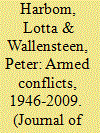

|
|
|
|
|
| Publication |
2010.
|
| Summary/Abstract |
In 2009, UCDP recorded 36 active armed conflicts, down by one from 2008. Having remained fairly stable over the past few years, the number of armed conflicts is now substantially lower than during the peak years of the early 1990s. But compared to the early years of this decade, the figure has increased by 24%. Six of the conflicts reached the level of war (more than 1,000 battle-related deaths) in 2009, up by one from 2008. No interstate conflict was recorded, but seven intrastate conflicts were internationalized, in the sense that one or both of the conflict parties received troops support from an external state. The most intense war in terms of fatalities was that in Sri Lanka. Eight of the armed conflicts listed for 2008 were not active in 2009, but during the year, one entirely new conflict erupted in Myanmar (Kokang), two were restarted by previously recorded actors in Angola (Cabinda) and in Rwanda and four previously recorded conflicts were restarted by new actors in Central African Republic, India (Bodoland), Nigeria and Yemen. Only one peace agreement was concluded during the year, which is decidedly lower than the annual average recorded for the past 20 years.
|
|
|
|
|
|
|
|
|
|
|
|
|
|
|
|
| 3 |
ID:
098409
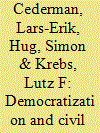

|
|
|
|
|
| Publication |
2010.
|
| Summary/Abstract |
The hypothesis that democratization triggers political violence has been proposed repeatedly in the quantitative literature, but it remains controversial with respect to both interstate and civil wars. Current empirical research continues to be afflicted by methodological and data problems related to the measurement of democracy and the task of detecting changes in such scores. In order to gain further clarity into the link between democratization and civil war, the current study introduces a new period-finding algorithm that is able to detect periods of democratization and autocratization. This allows for a more flexible way of finding directional changes in governance indicators than is possible with the rigid lag structures commonly employed in previous studies. When regressed on various measures of civil-war onset, the indicator for the initiation of a period of democratization has a strong and robust effect on conflict even in the presence of static measures of regime type. The same applies to autocratization, but its impact is much more sudden than that of democratization. Moreover, we find that the democratization effect is limited to governmental rather than territorial conflicts. Further research will be needed to confirm these results in terms of the relevant causal mechanisms, especially in ethno-nationalist civil wars.
|
|
|
|
|
|
|
|
|
|
|
|
|
|
|
|
| 4 |
ID:
098415


|
|
|
|
|
| Publication |
2010.
|
| Summary/Abstract |
This article analyses whether greater international trade, democracy and reduced military spending lower hostility between India and Pakistan. Conflict between the two nations can be best understood in a multivariate framework where variables such as economic performance, multilateral trade with the rest of the world, bilateral trade, military expenditure, democracy scores and population are simultaneously taken into account. The empirical investigation is based on time series econometrics from 1950- 2005, allowing causality to be examined. The results suggest that reduced bilateral trade, greater military expenditure, less development expenditure, lower levels of democracy, lower growth rates and less general trade openness are all conflict enhancing, albeit with lags in some cases. Moreover, there is reverse causality between bilateral trade, militarization and conflict; low levels of bilateral trade and high militarization are conflict enhancing, but conflict also reduces bilateral trade and raises militarization. Economic growth is conflict mitigating, but the reverse is not true. Globalization, or greater openness to trade with the rest of the world, is the most significant driver of a liberal peace, corroborating a modified form of the capitalist peace, rather than a common democratic political orientation suggested by the pure form of the Kantian liberal peace.
|
|
|
|
|
|
|
|
|
|
|
|
|
|
|
|
| 5 |
ID:
098412


|
|
|
|
|
| Publication |
2010.
|
| Summary/Abstract |
This article revisits the empirical relationship between oil and democracy. Existing studies establish a negative cross-country correlation between oil and democracy in a Pooled OLS framework. This insight has recently been challenged by claiming that it suffers from omitted variables, and that including country fixed effects removes the statistical association between oil and democracy. This article argues that because of the high persistence of democracy and oil, the findings of no effect of oil on democracy suffers from weak instrument problems and is not informative. Indeed, this article shows that levels of oil systematically predict both levels and changes in democracy in a sample of up to 156 countries between 1972 and 2002. By considering a different identification assumption for oil and by using additional and more informative moment conditions to instrument the regressors, this article demonstrates that the relationship between oil and democracy is negative also when country fixed effects are taken into account. This result holds for alternative measures of democracy and alternative measures of oil abundance; it is robust when including additional covariates and when removing major oil producers.
|
|
|
|
|
|
|
|
|
|
|
|
|
|
|
|
| 6 |
ID:
098410
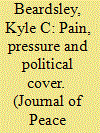

|
|
|
|
|
| Publication |
2010.
|
| Summary/Abstract |
This article explores the effect of domestic and international politics on the choice of mediation as a conflict management strategy in international crises. Existing work has yet to fully explore how domestic and international audiences shape the combatants' preferences for mediation. With regard to domestic pressures, combatants often desire mediation as political cover for unpalatable concessions. That is, intermediaries might obscure responsibility for disappointing outcomes or signal the prudence of compromise. In terms of international audiences, affected third parties eager to shape the resolution outcome might lobby to serve as a mediator. Since both domestic and international audiences are affected by the crisis severity, the article also explores how the pain of fighting conditions the effect of international and domestic political pressures. Empirical analysis of international crises since World War I confirms that potential domestic audience costs for seeking peace and the propensity for concessions positively affect the probability of mediation. Less clear is the role of third-party incentives; the results indicate that a higher potential for neighboring-state intervention actually decreases the likelihood of mediation. Consistent with previous studies, conflict costs increase mediation incidence, and the findings also indicate that at high costs of conflict, states appear in less need of political cover for making concessions.
|
|
|
|
|
|
|
|
|
|
|
|
|
|
|
|
| 7 |
ID:
098408


|
|
|
|
|
| Publication |
2010.
|
| Summary/Abstract |
Large-n studies of conflict have produced a large number of statistically significant results but little accurate guidance in terms of anticipating the onset of conflict. The authors argue that too much attention has been paid to finding statistically significant relationships, while too little attention has been paid to finding variables that improve our ability to predict civil wars. The result can be a distorted view of what matters most to the onset of conflict. Although these models may not be intended to be predictive models, prescriptions based on these models are generally based on statistical significance, and the predictive attributes of the underlying models are generally ignored. These predictions should not be ignored, but rather need to be heuristically evaluated because they may shed light on the veracity of the models. In this study, the authors conduct a side-by-side comparison of the statistical significance and predictive power of the different variables used in two of the most influential models of civil war. The results provide a clear demonstration of how potentially misleading the traditional focus on statistical significance can be. Until out-of-sample heuristics - especially including predictions - are part of the normal evaluative tools in conflict research, we are unlikely to make sufficient theoretical progress beyond broad statements that point to GDP per capita and population as the major causal factors accounting for civil war onset.
|
|
|
|
|
|
|
|
|
|
|
|
|
|
|
|
| 8 |
ID:
098411


|
|
|
|
|
| Publication |
2010.
|
| Summary/Abstract |
Existing work cannot explain why countries form alliances when direct security threats are not a key political issue, though we know countries routinely do engage in that behavior. Countries form alliances to manage the essential problem that they must use finite budget resources to provide social policy and national security; the 'guns versus butter' dilemma. States ally to 'contract out' national security via the formation of alliance contracts so they can allocate more resources to domestic concerns. Alliances increase the efficiency of security policy by providing the same level of security with fewer resources, thus freeing those resources for use in other domains. Not only should alliances form when security threats do not dominate the political agenda, but also domestic political and economic demands will influence alliance decisions. In positing a domestic politics-based explanation for alliance formation, this article argues that increased demands for social policy goods increase the chances of alliance formation as leaders seek greater policy allocation efficiency. The use of a production possibilities frontier illustrates the central argument. Those claims are examined on a sample of all country-years from 1816-2000 using a probit model. Empirical results suggest changes in the demand for social policy goods, operationalized as changes in the infant mortality rate, are an important cause of alliance behavior.
|
|
|
|
|
|
|
|
|
|
|
|
|
|
|
|
| 9 |
ID:
098416
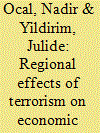

|
|
|
|
|
| Publication |
2010.
|
| Summary/Abstract |
The economic growth effects of terrorism have generally been examined in a cross-country framework where socio-economic differences among the countries are ignored. This highly restrictive assumption may result in heterogeneity bias, which could be overcome by resorting to country studies rather than cross-country analysis. Moreover, the relationship between the terrorist incidents and various factors may not be stationary in space. The majority of terrorist incidents in Turkey are concentrated mainly in Eastern, and South Eastern Turkey and big cities. Thus, the geographical dispersion of terrorist incidents in Turkey may result in uneven regional impact, necessitating local parameter estimates. This study analyses the effects of terrorism on economic growth across provinces of Turkey for the time period 1987-2001. Following a traditional global regression analysis, spatial variations in the relationships are examined with geographically weighted regression (GWR) to obtain locally different parameter estimates. A GWR approach allows the modeling of relationships that vary over space by introducing distance-based weights to provide parameter estimates for each variable and each geographical location. Empirical evidence indicates that a GWR model significantly improves the model fitting over the traditional global model. Even though the traditional convergence analysis reveals that terrorism hinders economic growth, GWR results indicate that its provincial effects are more pronounced for the Eastern and South Eastern provinces compared to the Western provinces. Moreover, empirical findings suggest that there is a considerable variation in speeds of convergence of provinces, which cannot be captured by the traditional beta convergence analysis.
|
|
|
|
|
|
|
|
|
|
|
|
|
|
|
|
| 10 |
ID:
098417


|
|
|
|
|
| Publication |
2010.
|
| Summary/Abstract |
Whether qualitative or quantitative, contemporary civil-war studies have a tendency to over-aggregate empirical evidence. In order to open the black box of the state, it is necessary to pinpoint the location of key conflict parties. As a contribution to this task, this article describes a data project that geo-references ethnic groups around the world. Relying on maps and data drawn from the classical Soviet Atlas Narodov Mira (ANM), the 'Geo-referencing of ethnic groups' (GREG) dataset employs geographic information systems (GIS) to represent group territories as polygons. This article introduces the structure of the GREG dataset and gives an example for its application by examining the impact of group concentration on conflict. In line with previous findings, the authors show that groups with a single territorial cluster according to GREG have a significantly higher risk of conflict. This example demonstrates how the GREG dataset can be processed in the R statistical package without specific skills in GIS. The authors also provide a detailed discussion of the shortcomings of the GREG dataset, resulting from the datedness of the ANM and its unclear coding conventions. In comparing GREG to other datasets on ethnicity, the article makes an attempt to illustrate the strengths and weaknesses associated with the GREG database.
|
|
|
|
|
|
|
|
|
|
|
|
|
|
|
|
| 11 |
ID:
098414
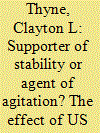

|
|
|
|
|
| Publication |
2010.
|
| Summary/Abstract |
This article takes a two-step approach to improving our understanding of how US foreign policy signals affect the likelihood of coups in Latin America. First, a large body of qualitative literature has developed a 'conventional wisdom' on this subject, suggesting that pressure from the USA plays a key role in stabilizing favored leaders and destabilizing unfavored leaders. Meanwhile, quantitative scholarship analyzing coups focuses almost exclusively on intrastate factors. The first step brings these two bodies of work together by providing quantitative evidence that hostile US signals increase the likelihood of coups, while supportive signals have a stabilizing effect. The second step moves beyond the conventional wisdom by (1) reconsidering theoretical assumptions within the conventional argument and (2) identifying anomalies within the preliminary empirical analyses. These efforts reveal several factors that are likely to impact how coup plotters respond to US signals. Among these factors, empirical analyses indicate that US signals are particularly important when economic dependence on the USA increases, during the middle of a US president's term in office, when they have moderate levels of consistency, and when they specifically mention the military. Overall, the first stage of this article provides a robust confirmation of the conventional wisdom, while the second stage moves the literature down a path that is largely unexplored by previous work.
|
|
|
|
|
|
|
|
|
|
|
|
|
|
|
|
|
|
|
|
|